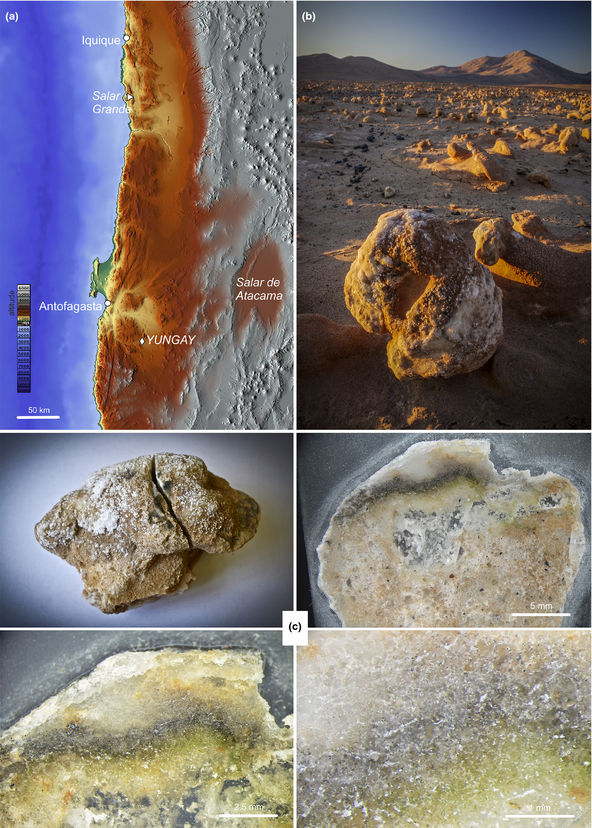
Also, you might think you can spot photosynthetic life easily because on Earth typically you crack open a rock or salt in a desert and you see a green stain which is a sign of photosynthetic life here. But would that work on Mars? Let's just look briefly at how easy it would be to see green on Mars, and what colour Mars life might be.
Green is a rare colour on Mars. Even purple is. So, you might think it would be easy to spot on Mars. You might have to break open a rock, but aftre that it woudl be easy to see. Here for instance is what green photsynthetic life looks like in the core of the Atacama desert.

Figure 2 from a paper on distribution of scytonemin, a UV protecting pigment, in cyanobacteria in the Atacama desert. Cyanobacteria typically are green, as are many (but not all) photosynthetic lifeforms on Earth. You'd think this would be easy to spot on Mars.
However, would Mars life be as easy to spot as this? There's one thing to look into briefly first. Colours such as green are likely to be hard for the human eye to spot on Mars. The problem is that light on Mars has a permanent reddish brown cast to it, because most of the blue light is filtered out of the sunlight by dust. Even if there were green rocks there, you wouldn't notice them, probably The pictures we see are all white balanced to help geologists on Earth recognize rocks. This for instance is what the Curiosity Mars dial looked like on Earth.
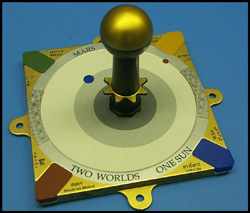
Curiosity Mars dial as photographed on Earth before attaching it to Curiosity.
This is what the same dial looks like on Mars. It hasn't faded. It's the same colours as before, but the reddish brown Mars light dulls out most of the variation of colours.

Curiosity's "Mars dial" colour calibration target as photographed on sol 69. Raw unprocessed image. This gives a rough idea of what it would look like to human eyes on Mars with the natural ambient light there.
The green patch there is barely distinguishable from the gold and even the bright red. To human eyes everything in the Mars landscape, however brightly coloured, will seem to have subtle shades of brownish gray.
The amount of blue light removed isn't that much actually; it's only reduced to between 42% and 62% of the original according to one study which was based on taking photographs of the calibration target (the "Mars dial" above). Even the red light is absorbed to between 60% and 80%. However, that imbalance is enough to change the balance of the colours significantly to human eyes.
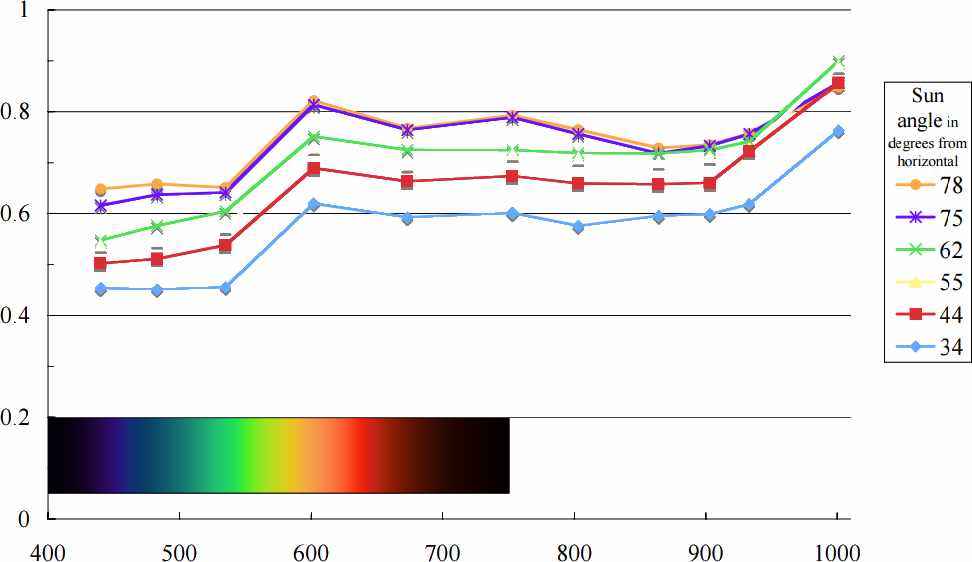
This shows the amount of light transmitted through the atmosphere for global sunlight from 400 nm to 1000 nm as measured using photographs of the Mars Exploration Rovers calibration target (compared with its pre-flight calibrated reflectance). This was at a time when the sky was reasonably clear of dust, though not at its clearest (in a scale according to which the optical depth 1 is more or less opaque, Opportunity had an optical depth about 0.94 for Opportunity and Spirit had a depth of 0.93 - in winter when the air is much clearer Spirit's optical depth goes down to 0.2). Shows the linear visible spectrum superimposed.
Here is the original image of the cyanobacteria in the Atacama desert adjusted with the red reduced to 80%, green and blue to 60%, and then increased in brightness (corresponding to the way our eyes auto balance the brightness of images). It's very approximate, just to give a rough idea of how the colours would change with Mars illumination.

That's why nearly all the images shared with the public here are white balanced - colour adjusted so that the brightest colour in the image is white. That's also presumably why the National Geographic Mars TV series had so many bright bright colours in them, on the suits, buildings, and the landscape much brighter and colourful than it would actually be. If they had shown the colours realistically as they would appear to human eyes, the scenes would have been dim and hard to make out.
So a visual search on Mars based on colour would be hard to do without enhanced vision. But this may not be too hard to fix. An easy way to deal with it would be to tint their spacesuit visors cyan to let through more blue and green and block out some of the red light. The landscape would be a bit darker but they could pick out colours more easily because with reduced red, the green and blue colours in the landscape would be more obvious.
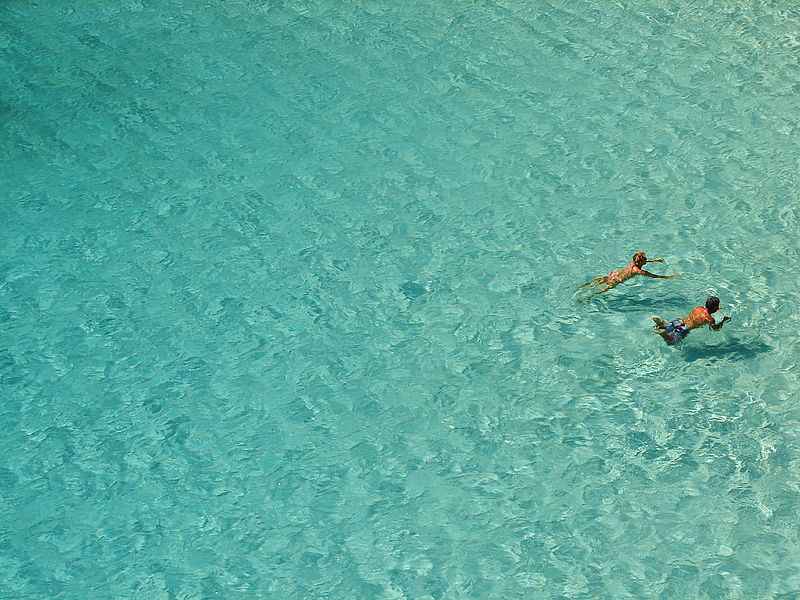
Cyan is the colour of white sand seen through shallow water because the water filters out red, leaving green and blue. Astronauts with cyan tinted goggles would see the Mars landscape with much of the red filtered out, in a similar way which could make it easier for them to see colours such as green and blue in the landscape.
So, this is a nuisance but it's not a big deal as we can just use cyan coloured spacesuit visors to fix it. This would make the landscape a bit darker, but especially if searching with the sun high above the horizon in the tropics then you should be able to see colours fine. When searching in low light conditions, digitally enhanced vision would help. When searching with robotic spacecraft or telerobotically then we can use digital enhancement automatically. What colour would the life be though?
What colour would Mars life be? H.G. Wells in War of the Worlds speculates that it could be a vivid blood-red.
"Apparently the vegetable kingdom in Mars, instead of having green for a dominant colour, is of a vivid blood-red tint. At any rate, the seeds which the Martians (intentionally or accidentally) brought with them gave rise in all cases to red-coloured growths."
Of course we now know that Mars doesn't have vegetation like Earth, but it could still have photosynthetic lichens and microbes. What colour would they be?
It's actually a bit of a puzzle why Earth photosynthetic life is green. After all the green colour of Chlorophyll means that it absorbs mainly blue and red light, It rejects light in the strongest part of the solar spectrum. Why aren't leaves dark red, or dark purple, or indeed black?
Perhaps it is all just a historical accident. Leaves might begreen because they get plenty of light, need to reflect some light away to resist dehydration, and there is no advantage in changing to black or purple. Or perhaps early life was indeed purple, absorbing green, like the modern haloarchaea, and photosynthetic green microbes originally evolved to take advantage of the light that the purple microbes rejected? That's the "Purple Earth Hypothesis" (abstract here). Or perhaps green is reasonably optimal anyway, once you take account of other effects?
At any rate, whatever the reason why so much Earth vegetation is green, yes, green photosynthetic life does work in Mars simulation experiments. So it could potentially have green photosynthetic life. But this is hardly the most efficient way to make use of the spectrum on Earth, and it would be even less effiicient on Mars with half the light levels of Earth and dust filtering out much of the light towards the blue end of the spectrum.
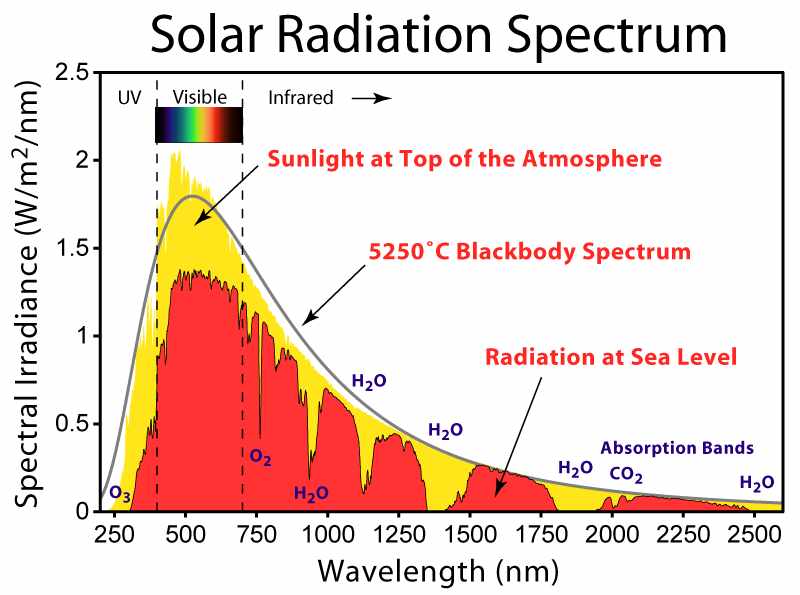
Solar radiation for direct light at the top of the Earth's atmosphere, and at sea level. Shows the linear visible spectrum superimposed.As you can see, we get more green light than any other frequency, yet for some reason, most of our vegetation is green. Would Mars photosynthetic life be green too?
Well actually, even on Earth we have many photosynthetic microbes that are are red, purple, or pink.
Lake Hillier in Western Australia, a "pink lake". It's pink partly because of the purple haloarchaea, and partly because of red carotene accumulating in a green algae dunaliella salina.
For instance Mars life could be like the purple haloarchaea which are able to survive in very salty conditions, and use Bacteriorhodopsin and Halorhodopsin for photosynthesis which resemble the pigment rhodopsin that we use for vision. Bacteriorhodopsin is a purple and absorbs green light most efficiently.
Lake Hillier is also pink because of ordinary green algae which have made carotenes, the same pigments that make a carrot red. These pigments absorb UV, violet and blue light, while scattering red and orange light. They dissipate some of this light as heat so protecting other organics such as proteins and membranes from the damaging effects of UV light, which would be useful of course on Mars. However, they also transmit some of the energy they receive to chlorophyll.
Pigments that can transfer energy to chlorophyll like this are known as "antenna pigments" and they do it by dipole to dipole coupling (the process is called Förster resonance energy transfer). carotene which they produced as UV protection and anantenna pigment to help convert some of the light to
There are many other antenna pigments which photosynthetic life on Earth uses, and so Mars life could probably use them too, or something similar. For instance, Cholrophyll b and xanthophylls (which colour egg yolks and autumn leaves yellow) have similar roles. Another exapmple is Lycopene which makes tomatoes red. Cyanobacteria and red algae also have phycocyanin and allophycocyanin which absorb orange light and a red pigment phycoerythrin which absorbs green light. Any of these could be useful on Mars
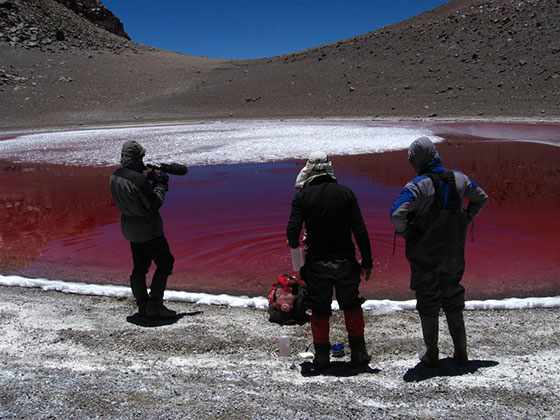
Deep dark red of algae in the crater lake of Mount Simba volcano at a height of 5,900 meters in the Altiplano, Chile. The microbes have developed special pigments to cope with extreme levels of UV. A few years ago the researchers measure what remains to this day the highest levels of UV measured in the world. Image credit SETI Institute/ NAI High Lakes Project
Life uses lots of different pigments to capture light in many areas of the spectrum. This next diagram shows how it works. For instance, Chlorophyll a can only absorb a narrow band of light in the red part of the spectrum (688) and Chlorophyll b in the blue part of the spectrum. But as you can see, there are other antenna pigments that help it take advantage of other parts of the spectrum, and Mars life could have these pigments, or similar ones, coloured purple, orange, pink etc in colour.

Part of Figure 1 from this study of the colour of life on Earth and exoplanets.
However, the most efficient way to do photosynthesis is to capture all the light that lands on a plant. And actually,, in low light conditions, photosynthetic life might be much more efficient at absorbing light than it is on Earth. Jack O’Malley-James of the university of St Andrews, Scotland, has suggested that life which evolved around red dwarf stars, especially binary star systems, could be dark in colour, or black, because it would receive far less visible light than Earth life does, so would need to make use of as much of it as possible. We do have black plants on Earth though they are rare.
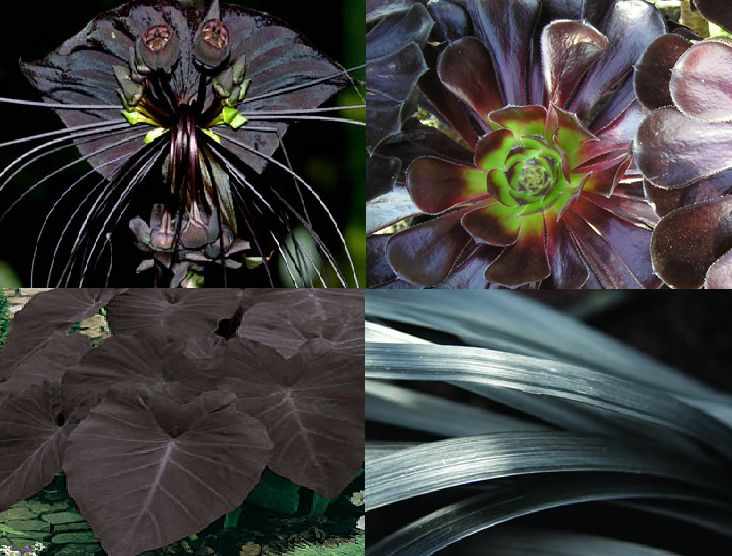 .
.
Examples of Earth vegetation with black flowers or leaves. When levels of light are low, then plants may become dark in colour or black to use as much of the spectrum as possible.
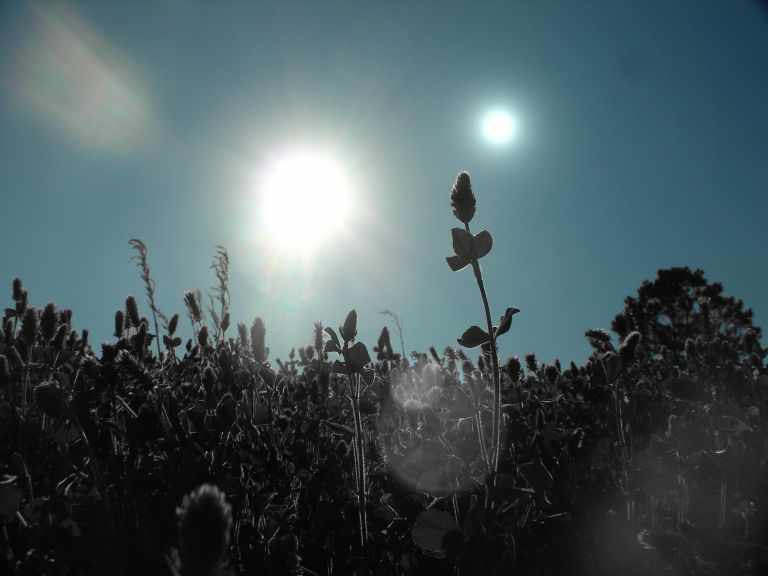
Possibilities for plant life under low light levels around other stars - perhaps in low light conditions the vegetation would be black.
We have dark coloured microbes too, as well as the black plants, and dark coloured seaweeds, some red algae and brown algae are nearly black, and grow in depths around 270 meters where the light is less than 1% of surface light. Life on Mars might experience not dissimilar conditions. Especially since any photosynthetic life is likely to be hidden in cracks or beneath thin layers of dust or underneath the crust of rocks in order to shelter from UV light. The red iron oxides of the Mars surface are especially good at filtering out UV light so photosynthetic life might well use it as protection from sunlight. This cuts down the available light even more. So Mars:
The next few diagrams show how Mars life will have to cope with low levels of light during dust storms:
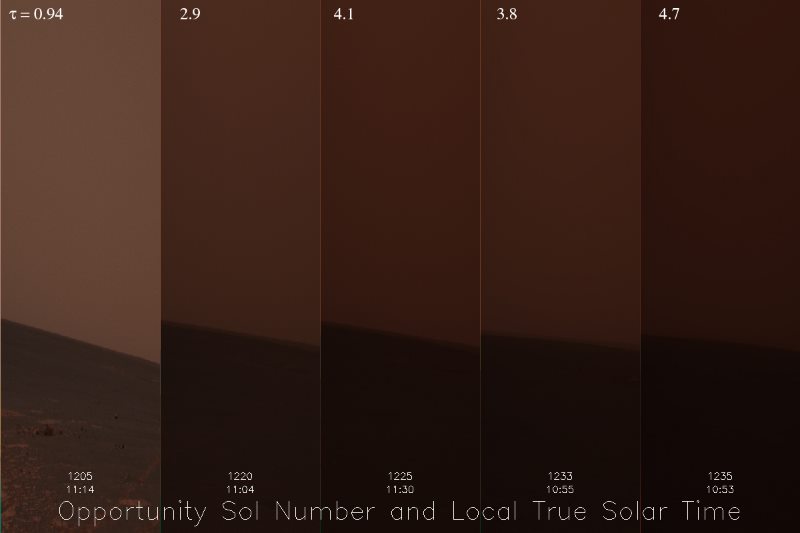
This shows photographs taken by Opportunity during a dust storm from sols 1205 to 1236 (one month). Each horizon view has been compressed horizontally (but not vertically). By the end of this period it reached a visual optical depth tau 4.7 which means that 99% of the sunlight was blocked. However that is for direct light. Of course the dust will also scatter a lot of light, and if you include ambient as well as direct light then the figures are not quite so extreme.
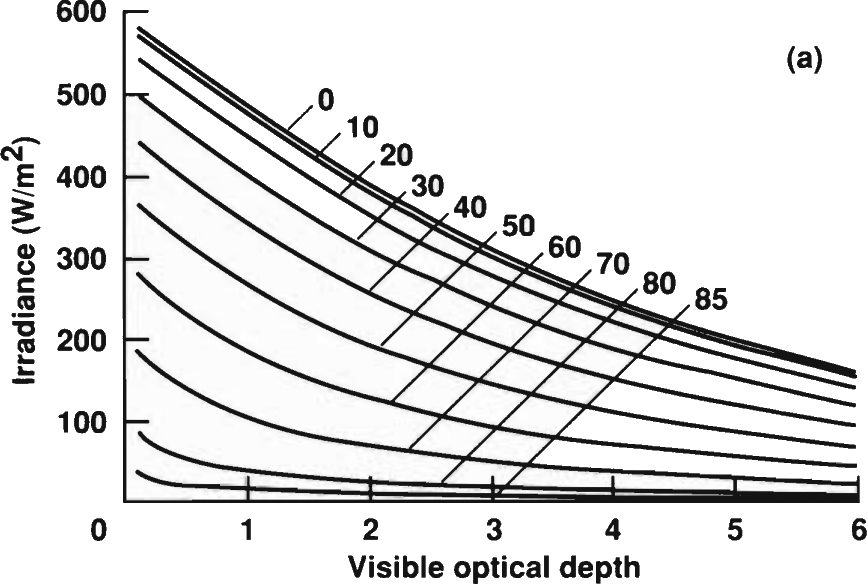
This shows theoretical prediction of the combined direct and ambient light for different optical depths on Mars. Here the optical depth is a number which is larger, the more the light is blocked out. Tau 4.7 corresponds to around 99% of direct light blocked, for instance during a dust storm on Mars. However, much of that light is scattered so adding to the amount of ambient light.
The curves in this graph show the amount of the combined direct and ambient light. The numbers 10, 20, 30 etc show the angle of the sun from the zenith - so with the sun at 90 degrees from the Zenith it's horizon skimming with very little light, and if there is an dust it goes through thick layers of dust, with almost no illumination.
So for instance, to find out how much light you get on the surface at the height of a typical dust storm go to around 4.7 in this diagram. Of the original 600 watts you still get around 200 watts when the sun is vertically overhead, at its zenith, even during a dust storm. But you get it greatly reduced when the sun is closer to the horizon, as you'd expect, almost to nothing.

This shows the irradiance for direct sunlight. Very much less. During a Mars dust storm there is almost no direct sunlight with the sun at any angle from the zenith, even if it is directly overhead. Graphs from this 1999 paper. Our ideas of Mars have changed a bit since then but not enough to make these significantly out of date I think, at least for our purposes here. If you know of more recent graphs do say.
So, during a dust storm there is almost no direct sunlight. The amount of indirect sunlight is cut to a third even when the sun is directly overhead, at the tropics, and much more at other times of day even in equatorial regions (and much more so at higher latitudes). So, this is just my own suggestion here. Might some Martian life have very dark photosynthetic life in order to take advantage of as much light as possible during dust storms? Kelp for instance and other forms of seaweed that are adapted to the lower light levelsi n the sea are often brown in colour, to absorb as much sunlight as possible.
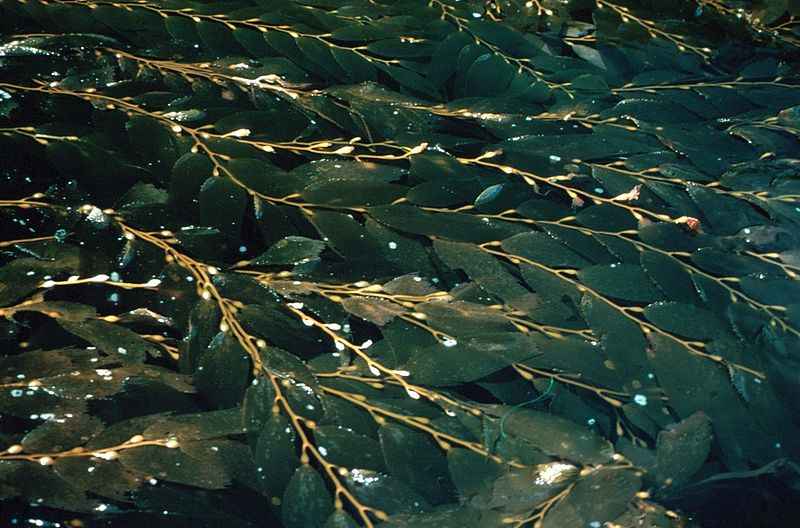
Giant kelp is brown to absorb as much sunlight as possible. It's coloured brown because of the accesory "antenna" pigment Fucoxanthin which absorgs light in the blue-green to yellow-green part of the spectrum. Some photosynthetic microbes are dark in colour too. In the conditions on Mars with dimmer light and the dust storms, might photosynthetic life on Mars be dark like this to use as much of the sunlight as possible for photosynthesis.
On the other hand, unless it is well sheltered by dust, or within rocks, it would also need to reflect away UV light for UV protection and may need to prevent desiccation. Perhaps another likely colour could be purple?
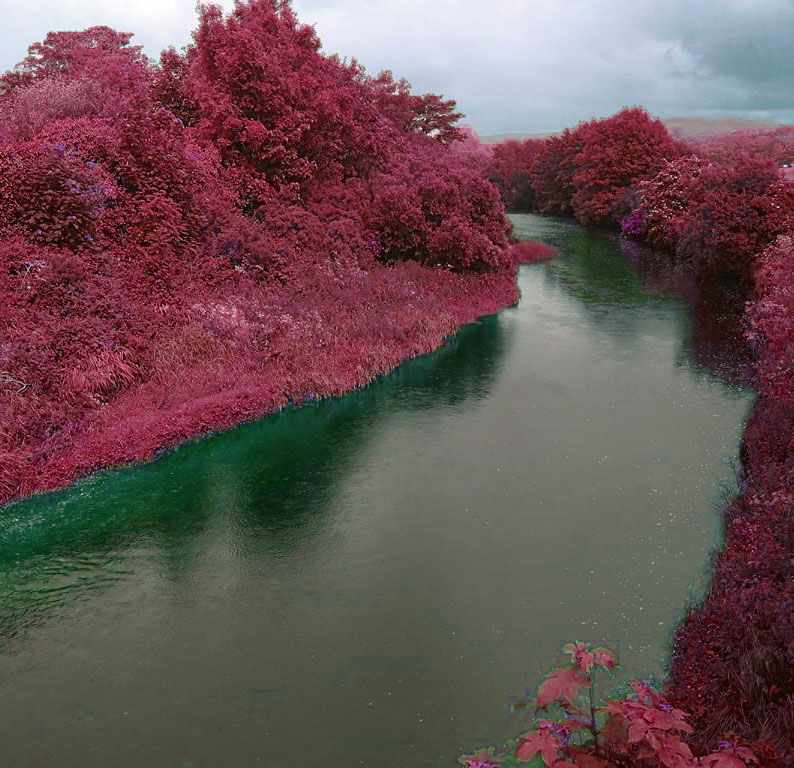
"Plants would appear darker under much dimmer, redder stars that emit more infrared than visual wavelengths of light but the color could vary widely"
Colour adjusted photograph by Tim Pyle of Caltech to illustrate possibilities for vegetation around other stars. Red dwarf stars particularly would have much more light in the red and infrared and photosynthetic life could have evolved to take advantage of it.
Or indeed, if it used iron oxides somehow for protection from UV light, it might be rust red in colour. So from those examples, it's hard to know what colour photosynthetic life on Mars could be. It might well not be green. It could easily be various shades of red, yellow, pink, purple, or indeed almost black, amongst other possibilities.
What about non photosynthetic life. Actually, we don't know if Mars does have photosynthesis. If it doesn't, then we will be looking for life depending on chemosynthesis, in salty brines perhaps, just below the surface, and it might well be that these are the first lifeforms we find anyway. If so, even if it doesn't photosynthesize, it can be damaged by UV. So, again, it's likely to use the red coloured surface rusty iron oxides for UV protection, or if it uses carotene for UV protection, it's again likely to be reddish in colour - for instance, one of our most ionizing radiation resistant microbes, Radiodurans ranges in colour from red to pink. It is that colour because of the presence of carotene for UV resistance, and is thought to have got its ionizing radiation resistance incidentally as a desert species from desiccation resistance (which has similar DNA damaging effects). Radiodurans requires oxygen (it's an obligate anaerobe) and can't photosynthesize, so it's not a candidate microbe for present day Mars. But it's an example to show that UV resistant non photosynthetic life could easily be reddish in colour on Mars.
So, even non photosynthetic UV resistant life might well be purple on Mars. This is one thing the National Geographic sequence got right. It seems quite possible that Mars could have purple lifeforms, or red, or pink, though it could also be many other colours such as black, orange, yellow, etc as well as green.
Rust coloured or red life would be hard to spot amongst the iron oxides even with filtered vision. And dark or black life, hidden beneath a layer of dust, or in the shadow of a crack, might be almost impossible to see by eye. If you crack open a rock on Mars, or srape away some dust, and the life is rust red, or dark brown, how would you recognize it?